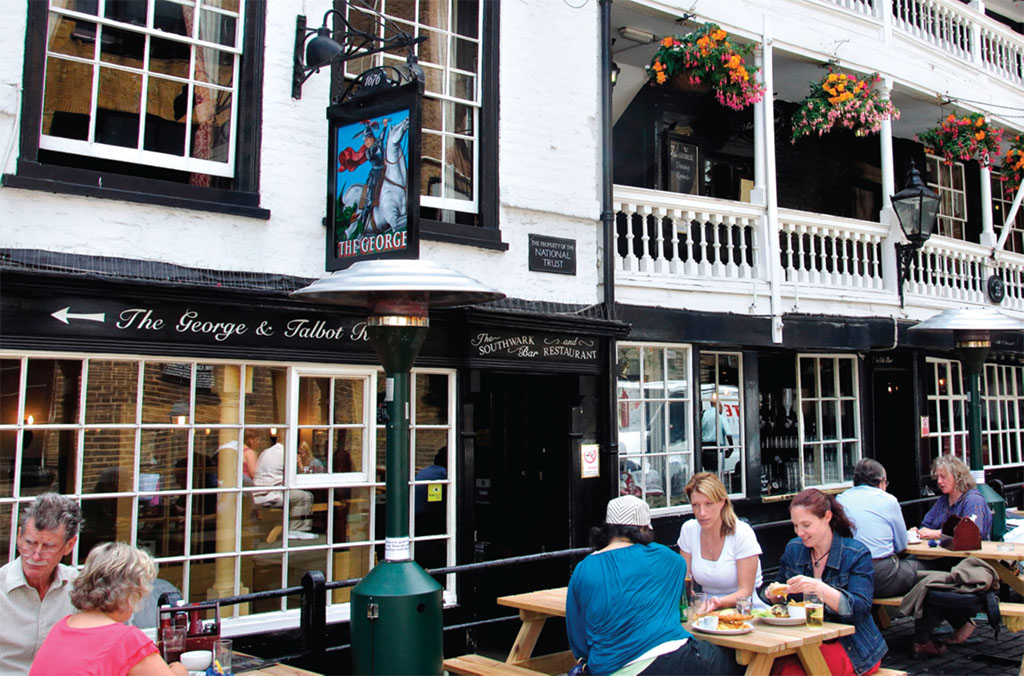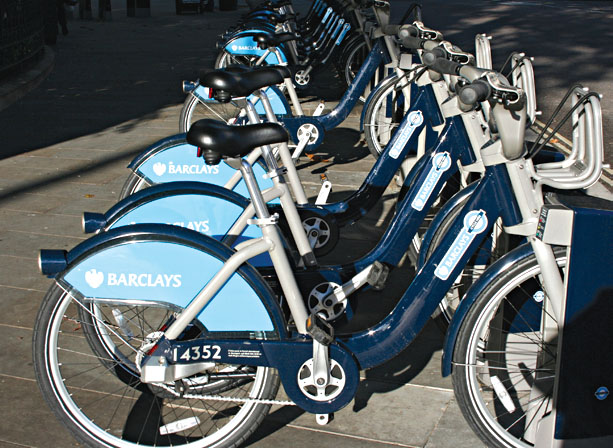
[caption id="BorisBikesaPlacebytheFireandGininTeacups_img1" align="aligncenter" width="323"]

AFTER WAITING NEARLY a year for London’s newest form of public transport, the Barclays Cycle Hire Scheme, to be available to anyone with a credit card, I suspect that, in retrospect, choosing one of the winter’s coldest afternoons to test out a “Boris Bike” (as they were christened on their very first day) may have been an error. It’s simple enough to hire one from any of the dozens of docking stations around the City and the West End, but it does help to enjoy full command of your fingers, rather than jabbing frozen digits at the touchscreen and hoping for the best.
[caption id="BorisBikesaPlacebytheFireandGininTeacups_img2" align="aligncenter" width="1024"]

© GREG BALFOUR EVANS/ALAMY
Tony and I were meeting friends on the South Bank for the legendary Twelfth Night Thames celebrations, so we picked up our bikes from just outside City Hall. The docking stations have been deliberately placed some distance from train and tube stations for reasons that remain a mystery. Perhaps it’s the mayor’s pledge to make us all fitter for 2012. Renting bikes is pretty easy—there are clear instructions and it works like any other credit card transaction. The only thing to remember is that if you’re booking more than one cycle on the same card you’ll need to insert it twice to get two release numbers.
Boris Bikes are designed for London’s roads, and the last thing you could ever describe them as is “chic,” but they do have a certain je ne sais quoi when you’re riding one. Against the odds, they’ve become quite a hip way to travel around town, and you’ll see all sorts, from trendy young things through to City businessmen, all pedalling furiously. You can tell if they’re regular users and not novices like me by how out of breath they are. I am used to riding my own bike, and I’ve never thought of it as light, but compared to Boris’ version, it’s a featherweight. Everything about the distinctive blue and silver cycles is solid, from the heavily upholstered seats, through the break-me-if-you-dare gear system to the pothole-defying tires which glide over the deepest ruts in London’s ice-ravaged roads with ease.
After paying your pound to hire the bike, the first half-hour’s cycling is free, the mayor calculating that most inner London trips can be done in that time. After that, the costs go up incrementally until after a couple of days when they assume you’ve cycled off with it into the sunset, and you get charged the cost of a replacement bike. It’s a triumph of design that these bikes are cool to ride around on, but not cool enough to pinch—they’ve only lost four since the scheme began, a stark contrast to Paris, whose rental bikes are so chi chi they’re always being stolen.
THIS MONTH’S CONTACTS
Barclays Cycle Hire
www.tfl.gov.uk/BarclaysCycleHire
The Lions Part Theatre Company
www.thelionspart.co.uk
The George Inn
www.nationaltrust.org.uk/main/w-georgeinn
The Last Tuesday Society
www.thelasttuesdaysociety.org
La Porchetta Pollo
is not the kind of place that has websites. Find it at 20, Old Compton Street, Soho
Although it was likely we’d miss the arrival of the Green Man at Bankside, we couldn’t resist having a little ride around, so we went over Tower Bridge (great fun), turned left at the Tower of London and pedalled into the City for a jaunt, finally crossing Southwark Bridge to meet our friends. My most consistent memory is of how I had lost all feeling in my hands by this point, but cycling around the City is a a lot less frightening than I had expected. Approaching the docking station by the Globe theater, we could hear cheers and shouts as the traditional free-combat play about St. George worked the Bankside audience to a frenzy (well, as much of a frenzy as sub-freezing London can manage) but we were thwarted by the Boris Bikes’ biggest drawback—no vacant places to park. You can press a button giving you extra time to find another docking station, but in reality there’s never one far away.
BY THE TIME we’d ditched the bikes, the mummers had moved on. Not that it was a problem. The celebrations, organised by the wonderful Lions Part theater company, had moved on to the George, a National Trust pub and the only galleried inn left in London. The George is perfect for these events, but it can get very crowded. My insider’s tip for such occasions is to repair to the Heeltap opposite—a modern bar that always seems empty, but serves good food and drink. You can sit there in comfort and admire the prettiness of the George.
Luckily for us, though, our friends had already secured us places by the fire in the George’s oldest bar, while the beribboned revellers were choosing the traditional King Bean and Queen Pea outside.
The Lions Part started out as an experimental company working with First Folio material, trying to perform Shakespeare’s works as his actors would have done, but they have branched out into all manner of traditional English folklore styles. Their Twelfth Night and October Plenty celebrations are big deals on the London calendar these days, but they also create other events throughout the year; it’s always worth checking what they’re up to. Perhaps we should have read their program a little more closely this time too. We had no sooner parked ourselves in the old bar (full of nooks, crannies, snugs and corners, fire burning brightly, seasonal greenery glowing against the black-painted wood) when the place became inundated. There must have been 150 people in a room that ideally seats around 30. It turned out that this was the room in which a fabulous Irish storyteller Patrick Ryan, was telling old tales. I guess that’s one of the things I love most about London—you just never know what you’ll find around the next corner.
[caption id="BorisBikesaPlacebytheFireandGininTeacups_img3" align="aligncenter" width="613"]

DANA HUNTLEY
SOME THINGS around London corners are almost too odd to describe. The notorious Last Tuesday Society is something I’ve wanted to attend for many moons, and I finally managed to get to an evening lecture. Held at Victor Wynd’s extremely strange emporium—part art gallery, part museum, part shop of erotica, part whimsy, Last Tuesday’s series of lectures cover anything and everything as long as it’s weird and wonderful. I let the one on “how to shrink heads” pass me by, and I shall probably do the same with “Panties Inferno—The Life and Times of Paul Raymond,” then sadly missed the discussion by Tim Knox on Sir John Soane, thanks to snow and London’s stupid transport system. I thought I’d be safe enough with Mr. Wynd himself telling tales from the Arabian Nights, though it turned out to be a sell-out—storytelling’s big in the capital just now.
We arrived early, so as to get good seats. This was probably a good thing, as there was currently also exhibiting a collection of alternative taxidermy. Since Tony had decided it wasn’t his cup of tea, I found myself squatting on giant cushions in the candlelight, between half a stuffed lion and a hyena who wouldn’t be laughing again any time soon. Above me flew a stuffed collie with wings, and a cuddly stuffed seal lounged playfully. It was a surreal experience, though greatly enhanced by large measures of Henderson’s gin (the company sponsors the series) served, naturally, with a slice of cucumber in tea cups with saucers. Victor Wynd himself, resplendent in a long robe, sat on a stool and told us tales of Eastern promise in a murmuring voice. I felt my eyelids droop.
We listened to stories of jinn and princesses, naughty servants and stupid masters. As we left, I noticed a disturbing display of jellies in the Dickensian Bethnal Green shop window. I guess that The Last Tuesday Society is one of the stranger experiences London has to offer, and it’s not for the faint-hearted (the museum definitely isn’t—I spent much of the time trying to work out what some artifacts actually were) but for a hardcore experience of where London’s art community is at just now, it’s well worth a visit. I shall be returning.
MY RETURN to the Pollo Bar was long overdue. It was somewhere I used to frequent in my student days, so it seemed fitting that when I accidentally remet someone I hadn’t seen since then we should end up there. It’s one of a quartet of dirt-cheap eateries that used to be on every student’s list—sadly the Centrale was lost several years ago, but the West End Kitchen in Panton Street (beloved of impoverished actors) the Stockpot (branches around the West End) and La Porchetta Pollo in Old Compton Street are still going strong.
The Pollo is my favourite by a long chalk. Redolent of the old gingham-and-Chianti-bottle-candleholders Italian restaurants of the 1970s, the range is large, the plates larger and the portions largest of all. Gigantic vats of steaming pasta, dishes of meatballs or plates of risotto are doled out by waiters who flirt outrageously just for the practice. It’s bright, steamy and often full—though rarely so busy they can’t take just a couple more people. Kay and I relived our student visits, remembering only too late that the house wine is undrinkable (if cheap) and that it’s never worth ordering a main course if you’ve already filled up on starters. I have still never had the opportunity of testing out the range of traditional Italian puddings. Look to spend about 10 pounds a head.
Next time I’ll be playing a new game based around Soho’s many watering holes, visiting yet another extremely peculiar museum and testing out London’s latest art-gallery restaurant.





Comments